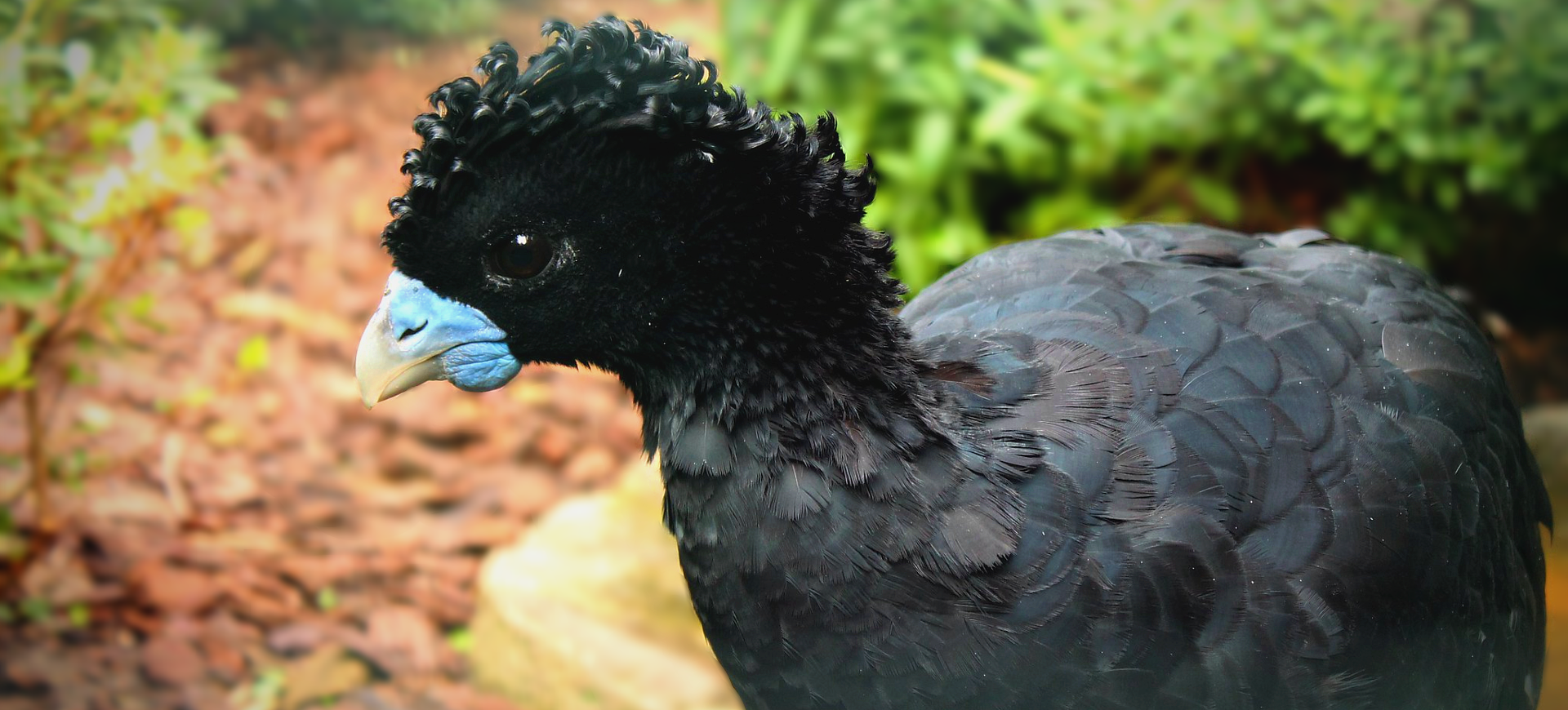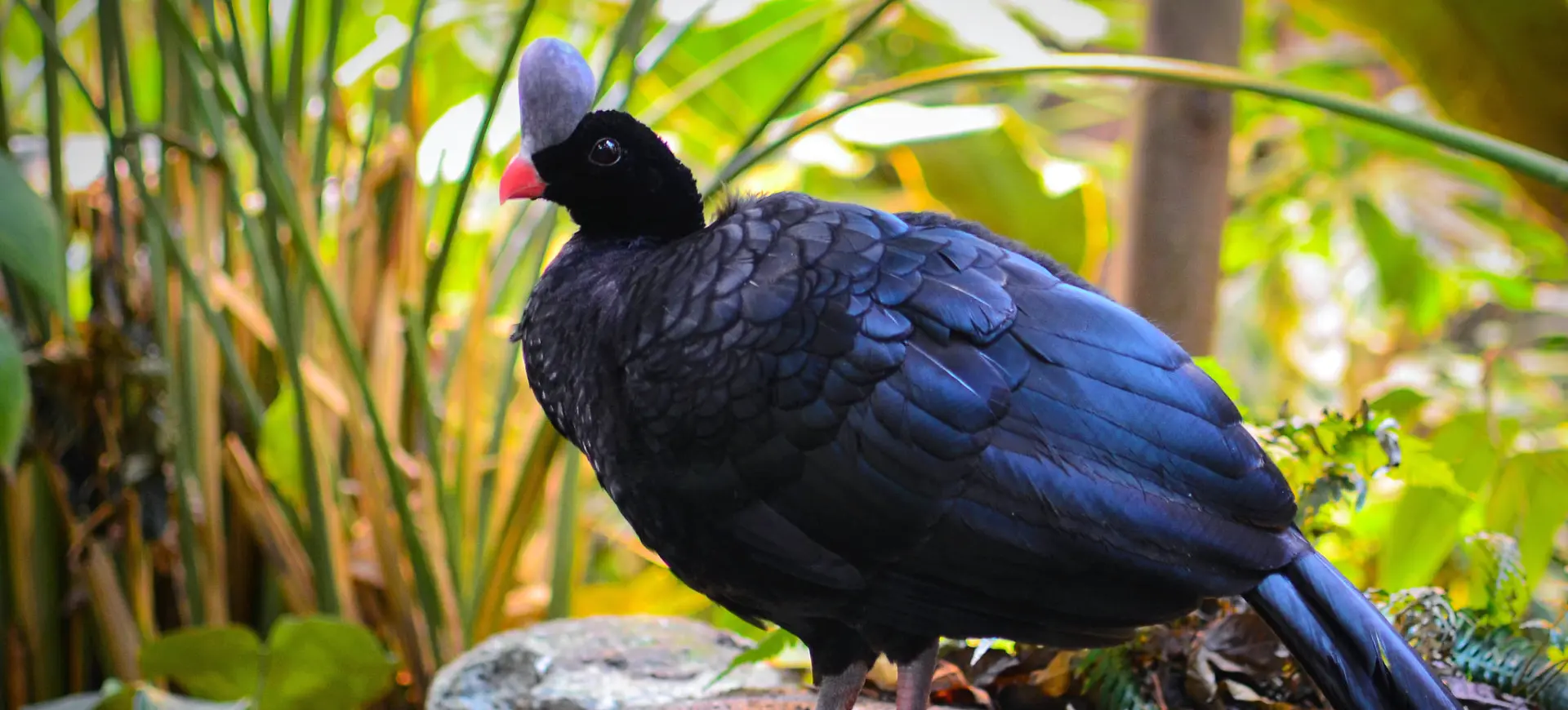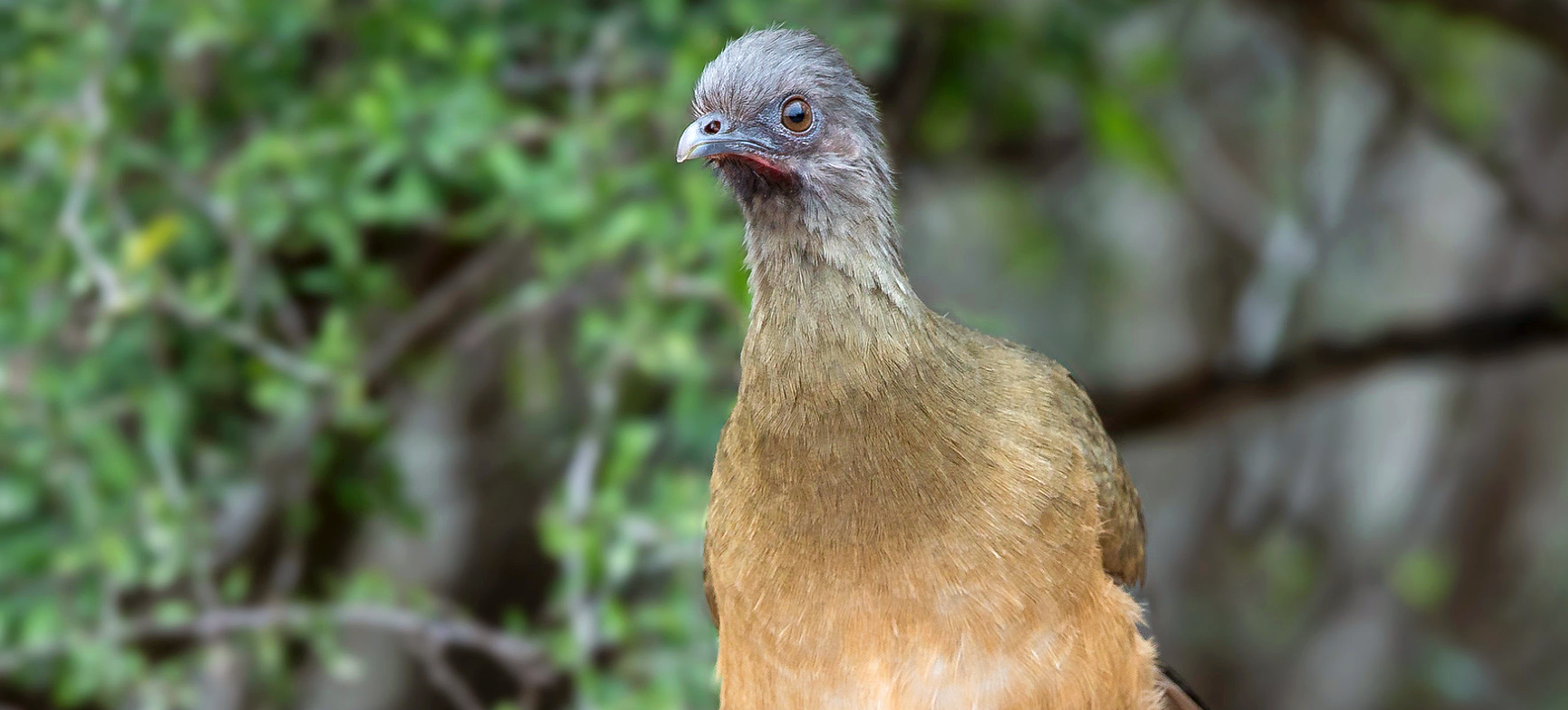Overview
The Wattled Curassow, scientifically known as Crax globulosa, is a large, striking bird in the Amazon Basin’s rainforests. It is part of the Cracidae family, which includes other cracids like guans and chachalacas. This species is notable for its glossy black plumage, distinctive curly crest on the head, and a prominent red wattle on the throat, which is more pronounced in males. The female is slightly smaller and less glossy than the male and has a smaller wattle.
Wattled Curassows are primarily frugivorous, feeding on fruits from the forest floor or low-hanging branches. They play a significant role in seed dispersal within their ecosystem, contributing to the health and diversity of their habitat. These birds are generally quiet but can emit various calls, including deep booming sounds and sharp alarm calls. They are most active during dawn and dusk, spending the day in dense forest undergrowth.
Wattled Curassows are rarely seen due to their elusive nature and preference for dense rainforest habitats. They are generally solitary or found in small groups, particularly during the breeding season. The destruction of their habitat, primarily due to deforestation and agricultural expansion, poses a significant threat to their survival. Conservation efforts are crucial for the preservation of this unique species.
Taxonomy
Kingdom
Phylum
Class
Order
Family
Genus
Species
Type
Physical Description:
The Wattled Curassow is a large bird with a body shape typical of the Cracidae family, characterized by a robust body and strong legs. The most striking feature is the bright red, fleshy wattle hanging from the throat, which is more prominent in males. The bird’s plumage is predominantly glossy black, with white-tipped tail feathers that are conspicuous in flight. The curly crest on the head, which is more pronounced in males, adds to its distinctive appearance.
Females are similar overall shape but have a duller black plumage with less gloss. Their wattle is smaller and not as brightly colored as the males. Both sexes have powerful, short wings adapted for rapid, short flights through the dense forest undergrowth. Their eyes are dark and expressive, providing sharp vision in the low light conditions of their rainforest habitat.

Lifespan: Wild: ~20 Years || Captivity: ~25 Years

Weight: Male: 6.6-8.8 lbs (3-4 kg) || Female: 5.5-7.7 lbs (2.5-3.5 kg)

Length: Male & Female: 32-34 inches (81-86 cm)

Height: Male: 28-30 inches (71-76 cm) || Female: 26-28 inches (66-71 cm)
Characteristic:
Native Habitat:
Wattled Curassows inhabit the dense, humid rainforests of the Amazon Basin. They prefer areas near rivers and streams, often close to water sources. Their ideal habitat includes a mixture of primary and secondary forests, providing ample food sources and cover from predators. These birds are adapted to life in the understorey, rarely venturing into open areas.
They depend highly on the intact rainforest ecosystem, which provides them with food, nesting sites, and protection. The complexity of the rainforest understorey offers them a haven, allowing them to remain hidden and undisturbed for much of the time. Their presence is often an indicator of a healthy, undisturbed rainforest environment.
Climate Zones:
Biomes:
WWF Biomes:
Biogeographical Realms:
Continents:
Diet:
Diet & Feeding Habits:
The Wattled Curassow’s diet consists of fruits from the forest floor or low-hanging branches. They prefer large, pulpy fruits, which they swallow whole. The seeds are later dispersed through their droppings, which is crucial in forest regeneration. They also consume small amounts of leaves, flowers, and invertebrates, supplementing their fruit-based diet.
Their foraging behavior is adapted to their rainforest environment, often quietly moving through underbrush to find food. They are capable of climbing small trees and shrubs to reach fruits. During the breeding season, additional nutrients, such as insects and small vertebrates, may drive them to consume more animal matter. Their feeding habits contribute to their role as key seed dispersers in their ecosystem.
Mating Behavior:
Mating Description:
Wattled Curassows are monogamous, forming pair bonds that last at least for the duration of the breeding season. Males perform elaborate courtship displays to attract females, which include strutting, wing-flapping, and vocalizations. The bright red wattle is also used in these displays, emphasizing the male’s fitness and attractiveness.
Nesting usually occurs in dense vegetation near water bodies. The female builds a nest, laying 2 to 3 eggs, which she incubates for about a month. The chicks are precocial, relatively mature and mobile shortly after hatching. Both parents raise the young, teach them to forage, and protect them from predators. The strong bond between the breeding pair is crucial for successfully rearing the chicks.
Reproduction Season:
Birth Type:
Pregnancy Duration:
Female Name:
Male Name:
Baby Name:
Social Structure Description:
Wattled Curassows are generally solitary or found in pairs, especially during the breeding season. They are not highly social birds, preferring to spend much of their time alone or with their mate. In the non-breeding season, they may form small, loose groups, particularly in areas with abundant food resources.
Their interactions are characterized by various vocalizations used for communication and territory establishment. They maintain territories and defend against other individuals, especially during the breeding season. The social structure of the Wattled Curassow allows for effective foraging and nesting in their dense rainforest habitat.
Groups:
Conservation Status:
Population Trend:
The population of Wattled Curassows in the wild is declining, primarily due to habitat loss and hunting. They are currently listed as Critically Endangered, reflecting their severe threats. The fragmentation of their habitat makes them more vulnerable to hunting and limits their access to key resources for survival and reproduction.
Conservation programs aim to protect the remaining populations by preserving and restoring their rainforest habitat. Efforts include creating and enforcing protected areas, promoting sustainable land use practices, and raising awareness about the species’ plight. The small number of individuals in captivity are part of conservation breeding programs, which aim to support wild populations.
Population Threats:
The primary threat to the Wattled Curassow is habitat destruction, mainly due to deforestation for agriculture, logging, and development. Hunting for meat and feathers is another significant threat, particularly in areas where their habitat overlaps with human settlements. The fragmentation of their habitat has also led to decreased genetic diversity, making them more susceptible to diseases and environmental changes.
Climate change poses a long-term threat by potentially altering their habitat and the availability of food resources. Changes in rainfall patterns and river levels can impact the structure of the rainforest, affecting the Wattled Curassow’s ability to find food and nest. Conservation efforts must address these challenges to ensure the survival of this species.
Conservation Efforts:
Conservation efforts for the Wattled Curassow focus on habitat protection and restoration. This includes establishing and managing protected areas within their range and preserving key habitats. Environmental education and community engagement are also critical, promoting sustainable practices and reducing hunting pressure.
In-situ and ex-situ conservation programs are working to increase the population of Wattled Curassows. Captive breeding programs aim to reintroduce individuals into the wild, bolstering existing populations. Research on their ecology and behavior is essential to inform conservation strategies and improve the chances of successful reintroduction and population recovery.
Additional Resources:
Fun Facts
- Wattled Curassows are excellent swimmers, often seen swimming across small rivers or streams in their rainforest habitat.
- The species is known for its distinctive booming call, which can be heard echoing through the rainforest, particularly during the breeding season.
- They have a unique ability to consume large fruits whole and play a critical role in seed dispersal for several rainforest plants.
- Unlike many other bird species, the Wattled Curassow’s wattle, a fleshy ornament, does not serve any known practical function in feeding or survival.
- These birds can be quite secretive and elusive, making them difficult to observe in the wild.
- The Wattled Curassow’s curly crest is a unique feature among birds and is more pronounced in males than females.
- They have a relatively long lifespan, potentially living over two decades in the wild.
- The species is considered a “landscape species” by conservationists, meaning its conservation helps protect many other species in the same habitat.
- Wattled Curassows are mostly terrestrial but will roost in trees at night for safety.
- They have strong legs and can run quickly on the ground to escape predators or danger.








